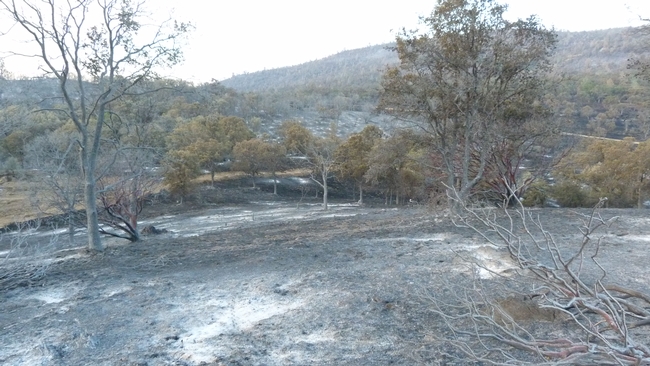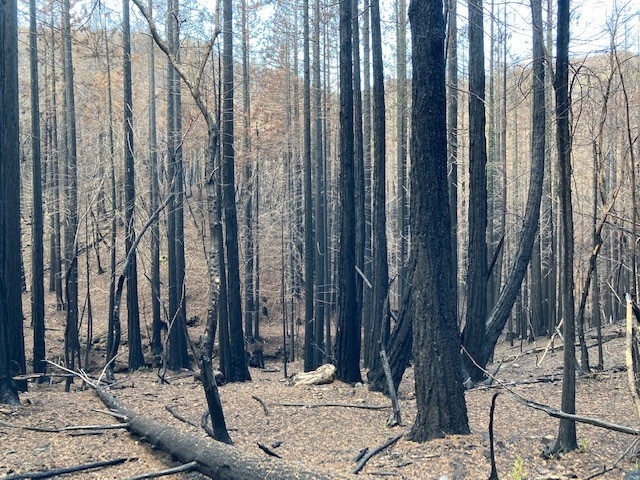Now that the traditional fire season is nearing an end, it is never too late to think about steps to take before a wildfire impacts your home and forest. According to the Cal Fire Incidents Overview website, the 2021 fire season to date has either damaged or destroyed 3,629 structures and burned almost 2.5 million acres. For those private forest landowners impacted by these fires, claiming a casualty loss on their federal and state tax returns can help mitigate financial losses.
Larry Camp, a California forest landowner, California Registered Professional Forester, member of Forest Landowners of California, and retired IRS forester, gives us a brief overview of what a casualty loss is and what steps a landowner needs to take in order to determine a loss.
What is a casualty loss? In broad terms,a casualty loss for forest landowners is defined as a loss incurred if such losses arise from sudden and unexpected events such as fire, storm or theft. This resulting damage may directly impact your forest business, trade or other activities that produce a profit.
Forest ownership type matters. Tax treatment for casualty losses varies for property held as personal property, for investment purposes, or as a trade/business. Generally, homes within forested subdivisions settings, or smaller acreages, e.g. 5 acres or less, where periodic timber harvest would be marginal for economic reasons, would be considered personal property. Since 2017, casualty losses for federal tax purposes for all types of forest property ownership are generally not deductible unless the loss is within an area declared as a Federally Declared Disaster area. However, property owned and managed as a business may be eligible for a business loss due to a fire or other casualty event. California has not amended its statutes to conform to Federal law as of mid-October 2021.
How much loss a landowner can claim depends on the adjusted basis or the change in fair market value “before” and “after” the occurrence of the casualty.
What is basis? Basis is the cost of something when purchased, or received as a gift or inheritance and is used to determine taxable income, capital gains, and casualty losses among other purposes. Because tax treatment varies by asset type, total basis for timbered properties needs to be allocated to different subaccounts such as land, timber, and improvements like roads and structures. It is always best to make the allocation to these accounts at the time of purchase. However, basis can be calculated after the fact with the help of a Registered Professional Forester, an appraiser, and tax advisor.
What steps need to occur in order to claim a casualty loss?
- Determine what your basis is.
- Deduct from your preliminary estimated casualty loss any proceeds from insurance, judicial judgments and/or salvage harvest of dead and damaged timber.
- For personal property, determine if the property is within a Presidentially Declared Federal Disaster Zone and within the time frame identified in the Disaster Declaration.
- Ascertain and gather available documentation to demonstrate that the loss was sudden and unexpected, e.g., photos, management plans, harvest records. This is often best done at the time of acquisition of the property, and periodically, such as every 3 to 5 years.
- Have an appraisal done to reflect the “before” and “after” value of the property. Note that acceptable appraisals will often require the services of a state licensed appraiser or forester with formal appraisal training and must meet required standards.
Other considerations and resources…
- Investment and business ownership of forestland have other factors that need to be considered when claiming a casualty loss. Talk with your tax professional to determine the appropriate steps to take.
- Additional consideration for taxpayers who itemize deductions may result in no deductible loss in the year of the casualty. Special provisions for taxpayers who do not itemize deductions also must be considered. Consult with your tax advisor.
- For a much more in-depth explanation of timber casualty loss, please visit Forest Landowners of California website at: ForestLandowners.org.
Disclaimer: The purpose of this document is educational and is general in nature. It is NOT intended to provide legal or accounting advice, since the facts and circumstances of each taxpayer's individual situation need to be taken into consideration for an appropriate application of the tax law and associated regulations related to the preparation or filing of a completed tax return. Questions should be discussed with your accounting, legal and other appropriate professional advisors.

